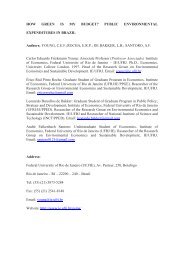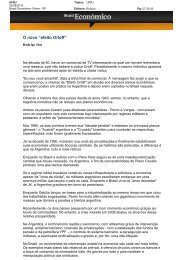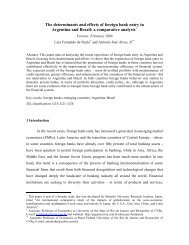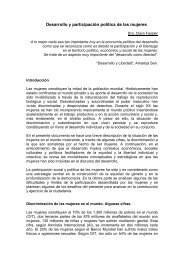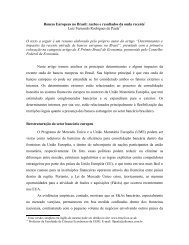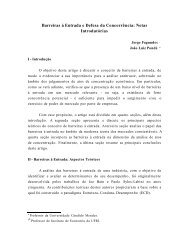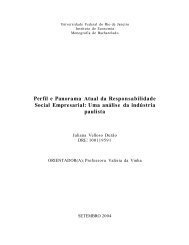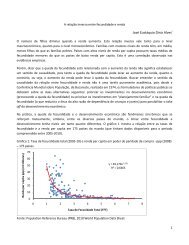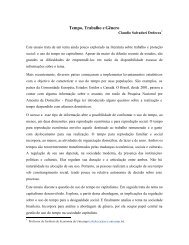Trade Integration for the Americas: What Can Economic Analysis ...
Trade Integration for the Americas: What Can Economic Analysis ...
Trade Integration for the Americas: What Can Economic Analysis ...
- No tags were found...
Create successful ePaper yourself
Turn your PDF publications into a flip-book with our unique Google optimized e-Paper software.
13reasons, it is not surprising to find greater trade between neighbors than those located at agreater distance. On <strong>the</strong> basis of <strong>the</strong>se simple contentions and observations, gravitymodels of international trade have been developed. The basic notion (and equation) positsthat trade between countries is a function of distance and GDP, i.e., <strong>the</strong> smaller <strong>the</strong>distance between markets and <strong>the</strong> larger <strong>the</strong> market size (as measured by GDP), <strong>the</strong>greater will be <strong>the</strong> trade flows between <strong>the</strong>m. Empirically, <strong>the</strong> gravity models measuringbilateral trade in terms of variations of <strong>the</strong> distance and market size variables are veryrobust. 12 There is indeed a tendency <strong>for</strong> neighbors to trade more with each o<strong>the</strong>r than withthird, and more distant, parties.Gravity model estimation typically posits trade flows as a function of five basicexplanatory variables: market size, per capita incomes, distance, common borders andcommon languages. In general, in studying <strong>the</strong> <strong>for</strong>mation of RTAs ex post, RTAaffiliation accounts <strong>for</strong> a positive factor beyond <strong>the</strong> five basic explanatory variables in <strong>the</strong>equation. This is taken to imply benefits from RTA <strong>for</strong>mation.The limitations of gravity models to examine trade policy choices are fairlyevident. The models are best suited <strong>for</strong> examining bilateral trade and more difficultlyadapted <strong>for</strong> examining RTAs. The models measure trade flows, which are inherently lessinteresting than economic welfare, which is not measured. Moreover, gravity modelmeasurements are ex post ra<strong>the</strong>r than ex ante and <strong>the</strong>re<strong>for</strong>e have little predictive value.For <strong>the</strong>se reasons, gravity models, while capable of providing important insights, are notwidely used <strong>for</strong> examining <strong>the</strong> potential impact of different trade policy options orarrangements, including RTAs.IV. Some General Findings and Implications <strong>for</strong> <strong>the</strong> <strong>Americas</strong>A. The FTAA Option Once Again: Anything New?Ever since <strong>the</strong> Free <strong>Trade</strong> Association of <strong>the</strong> <strong>Americas</strong> (FTAA) was firstproposed in <strong>the</strong> early 1990s, it has been surrounded by controversy, mostly of a politicaland/or ideological nature. This political discussion has most frequently dominated <strong>the</strong>economic discussion. But <strong>the</strong>re are important economic dimensions as well. <strong>What</strong>, <strong>for</strong>example, can be expected to happen to <strong>the</strong> economic welfare <strong>for</strong> <strong>the</strong> prospective membercountries? Will Country X be better off or worse off? There is indeed some evidencefrom economic analysis, which, predictably enough, is largely ignored by <strong>the</strong> politicalactors.The evidence regarding <strong>the</strong> most relevant economic effects – those <strong>for</strong> economicwelfare – has been developed with <strong>the</strong> use of CGE models. Some illustrative evidence ispresented in Table 5. The results <strong>for</strong> two different studies are reported: (a) a study byHarrison, Ru<strong>the</strong>r<strong>for</strong>d, Tarr and Gurgel (hereafter termed HRTG) undertaken under <strong>the</strong>12 For a solid analysis of gravity models, along with a development of <strong>the</strong> implications <strong>for</strong> RTAs, seeFrankel (1997).



